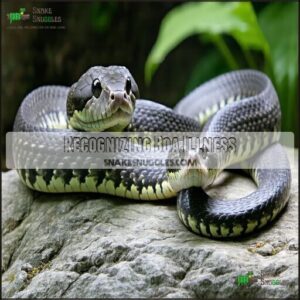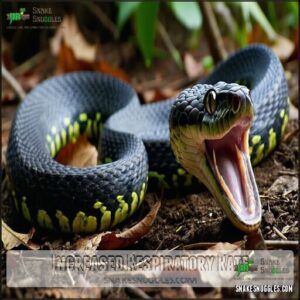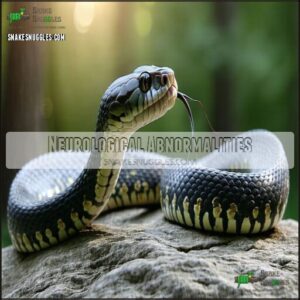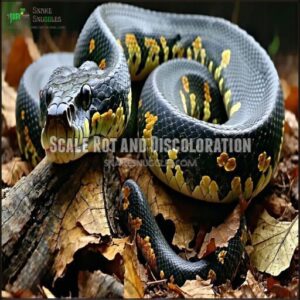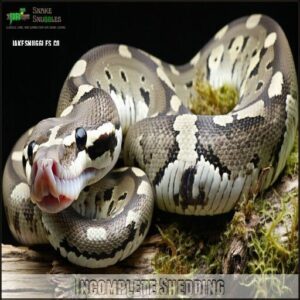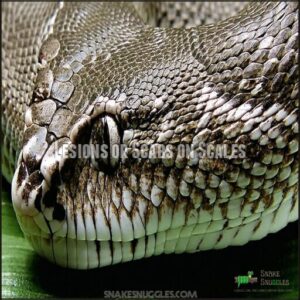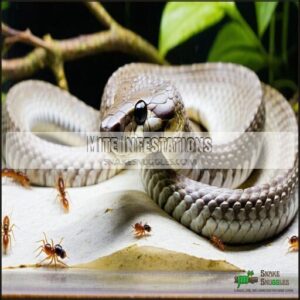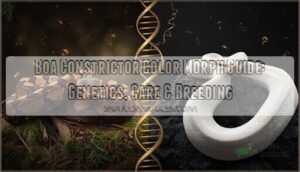This site is supported by our readers. We may earn a commission, at no cost to you, if you purchase through links.
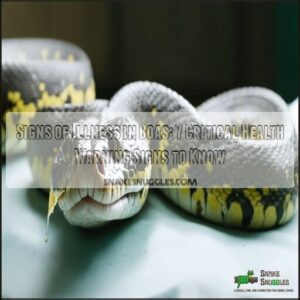
Watch for red flags like drastic appetite changes, wheezing, or weird shedding patterns.
Abnormal discharge from eyes or mouth, unusual skin discoloration, and sudden weight loss are serious warning signs.
Your snake might seem lethargic, have breathing difficulties, or show neurological symptoms like tremors.
Scale rot, incomplete shedding, and visible parasites are also critical indicators something’s wrong.
These signs of illness in boas can quickly escalate, so trust your gut and consult a reptile vet pronto if anything seems off.
Remember, early detection is your snake’s best defense.
Table Of Contents
Key Takeaways
- You’ll want to monitor your boa’s appetite, shedding, respiratory function, and neurological signs – these are critical early warning indicators of potential health problems.
- Watch for unusual discharge, abnormal skin discoloration, or persistent changes in behavior, as these can quickly signal serious underlying health issues that require immediate veterinary attention.
- Your snake’s environment plays a crucial role in its health, so you’ll need to maintain proper humidity, temperature, and cleanliness to prevent infections, scale rot, and respiratory complications.
- Don’t ignore subtle symptoms like head tremors, weight loss, or irregular shedding – early detection and prompt professional intervention can make the difference between successful treatment and a life-threatening condition.
Recognizing Boa Illness
If you’re a boa constrictor owner, you’ll want to keep a sharp eye out for subtle changes that could signal your snake’s health is at risk.
By understanding the critical warning signs and acting quickly, you can catch potential illnesses early and make certain your scaly friend stays in shape.
Changes in Appetite
Appetite fluctuations in boas can be the canary in the coal mine of potential health issues.
When your boa starts refusing food or shows inconsistent eating patterns, it’s time to pay attention.
Unusual changes in feeding frequency, like a sudden prey size preference shift or complete food rejection, might signal underlying stress, parasites, or more serious health problems.
Altered Stool or Urine
When your boa’s diet changes, so might its waste.
Watch for these urine and stool warning signs:
- White chalky urine with unusual consistency
- Blood in droppings signaling potential parasites
- Hardened ventral area near cloaca indicating impaction
- Liquid stool inconsistent with your snake’s age
These indicators reveal critical kidney function and digestive health clues, helping you catch boa illness signs early.
Discharge or Redness in Eyes
After tracking stool changes, watch your boa’s eyes closely for warning signs.
Keep a watchful eye on your boa’s eyes—they reveal hidden health secrets lurking beneath the scales.
Redness, discharge, or cloudy appearance can signal serious eye infections or corneal damage.
These boa eye problems might stem from vitamin deficiency, retained spectacles, or hidden parasites.
It’s worth pointing out that dehydration signs like sunken eyes can also manifest in this area.
Quick veterinary intervention prevents permanent vision loss and protects your slithery friend’s overall health.
Abnormal Skin or Shedding Patterns
Watch your boa’s skin like a hawk—abnormal shedding patterns can scream serious health troubles.
Dysecdysis signals underlying issues like stress, parasites, or nutritional deficiencies.
Healthy skin should look smooth and vibrant, with complete, easy sheds.
Partial or stuck skin indicates potential scale abnormalities, demanding immediate attention to prevent further complications.
Respiratory Issues
If you’re a boa constrictor owner, you’ll want to keep a keen eye on your snake’s breathing patterns.
Wheezing, gasping, nasal discharge, or open-mouth breathing can be telltale signs that your slithery friend is battling a potentially serious respiratory issue.
Wheezing or Gasping
If your boa’s breathing sounds like a wheezy accordion, it’s time to take notice.
Keep a keen eye on your boa’s breath—a wheezy whisper could signal a slithering health storm.
Wheezing or gasping signals serious respiratory distress, often linked to pneumonia or environmental stress.
Changes in humidity levels and temperature control can trigger these breathing sounds.
Prompt veterinary care is imperative when you hear abnormal respiratory infections developing in your snake’s breathing.
Nasal or Oral Discharge
If you spot a slimy trail or funky discharge from your boa’s mouth or nose, you’ve got a red flag for respiratory infections.
These nasty symptoms signal potential bacterial or viral troubles that can quickly turn serious. Veterinary diagnosis is paramount—don’t wait.
Check the discharge’s color, consistency, and accompanying symptoms to understand infection severity and get proper treatment options.
Open-Mouth Breathing
If nasal discharge has caught your attention, open-mouth breathing could signal serious trouble.
Your boa might be battling a respiratory infection that demands immediate action.
- Represents a potential life-threatening respiratory condition
- Can indicate pneumonia, septicemia, or viral diseases
- Signals urgent need for professional veterinary examination
Quick medical intervention could mean the difference between recovery and a critical health decline.
Don’t wait—seek expert help when you notice unusual breathing patterns.
Increased Respiratory Rate
If open-mouth breathing raised red flags, an increased respiratory rate is another telltale sign of trouble.
Rapid, labored breathing signals your boa’s respiratory distress could be sliding toward pneumonia.
When your snake’s breaths become quick and shallow, effort precedes decline. Rate monitoring becomes critical—any abnormal breathing patterns demand immediate veterinary attention for this serious boa respiratory infection.
Environmental factors can exacerbate these issues.
Neurological Abnormalities
If you’re a boa constrictor owner, you’ll want to watch for neurological red flags that could spell serious trouble for your scaly friend.
Head tremors, star-gazing behavior, and loss of coordination aren’t just quirky snake moves—they’re potential signs of a critical health issue that demands your immediate attention.
Head Tremors
Occasionally, head tremors in boas signal serious neurological issues, often linked to Inclusion Body Disease (IBD).
These involuntary movements might indicate a critical health problem on the Severity Scale.
Diagnostic tests can reveal underlying causes, from viral infections to metabolic disorders.
If you notice persistent tremors, consult a reptile veterinarian immediately for proper treatment options.
Loss of Coordination
When a boa’s world starts spinning, loss of coordination signals serious neurological red flags. Balance problems can transform your snake from a graceful predator to a struggling patient.
- Muscle weakness disrupts normal movement patterns
- Neurological damage affects striking and constricting abilities
- Severity stages indicate potential underlying health complications
Watch for unsteady slithering, unexpected tumbling, and reluctance to move—these are your boa’s distress signals demanding immediate veterinary attention.
Star-Gazing Behavior
As loss of coordination signals deeper neurological troubles, star-gazing behavior emerges as a red flag for serious boa constrictor health issues.
This unusual posture, where your snake keeps its head raised upward, often indicates advanced neurological disorders like Inclusion Body Disease (IBD).
| Symptom | Interpretation |
|---|---|
| Head Pointed Upward | Potential Neurological Damage |
| Persistent Positioning | High IBD Correlation |
| No Response to Stimuli | Severe Neurological Impairment |
| Uncontrolled Head Movement | Advanced Disease Progression |
Inability to Strike or Constrict
At the heart of boa constrictor well-being lies the critical ability to strike and constrict prey—a skill that, when compromised, signals serious neurological concerns.
- Muscle weakness disrupts precise prey handling
- Neurological causes undermine strike accuracy
- Coordination loss impacts constriction strength
- Potential disease progression threatens survival
- Early detection prevents further health complications
Understanding these symptoms can save your snake‘s life.
Skin and Shedding Problems
If you’re a boa constrictor owner, you’ll want to keep a keen eye on your snake’s skin and shedding patterns, as these can reveal key health information.
Watch out for signs like scale rot, incomplete sheds, or suspicious lesions that might indicate your slithery friend isn’t feeling its best.
Scale Rot and Discoloration
When dark, mottled patches appear on your snake’s scales, it’s time to sound the alarm for potential bacterial infections.
Scale rot thrives in damp, unclean environments, turning your boa’s once-smooth skin into a warning sign of serious health issues.
Proper humidity control and careful enclosure hygiene are your first line of defense against these skin problems.
You can find effective scale rot treatments online.
Incomplete Shedding
Got stuck with a snake that can’t seem to shake off its old skin?
Incomplete shedding, or dysecdysis, can signal deeper health issues in your boa constrictor.
Low humidity levels, poor nutrition, and stress often trigger shedding problems.
A key indicator is retained eye caps.
Don’t panic! Watch for retained skin patches and consult a reptile vet who can provide targeted shedding aids and expert guidance.
Lesions or Scabs on Scales
Wondering what those strange lesions mean on your boa’s scales? These scaly battle scars could signal serious health issues.
Your snake’s skin tells a story of potential bacterial infections or trauma.
Key infection indicators include:
- Persistent open wounds
- Discolored scale patches
- Raised or hardened skin areas
- Irregular scar tissue formation
Watch closely and consult a reptile vet promptly to prevent scale damage escalating.
Mite Infestations
Building on scale problems, mite infestations can turn your boa’s skin into a tiny battlefield.
These bloodsucking parasites hide in scale crevices, causing restlessness and skin irritation. Spot them as black dots, especially near eyes.
Effective treatment often involves using a suitable snake product.
Quick identification and thorough enclosure sanitation are key to treating snake mites and preventing widespread boa parasite infection.
Your snake’s health depends on prompt action.
Internal Health Issues
Regarding your boa’s internal health, you’ll want to keep a sharp eye out for subtle changes that could signal serious issues.
From chronic regurgitation to sneaky internal parasites, these warning signs can make the difference between a thriving snake and a medical emergency.
Chronic Regurgitation
After battling scale issues, your boa might face another health challenge: chronic regurgitation.
This troubling condition can signal deeper problems in your snake’s diet and well-being.
Watch for these red flags:
- Food expelled 3-5 days after feeding
- Repeated vomiting episodes
- Signs of stress during digestion
- Potential bacterial or IBD complications
Catch it early to prevent serious dehydration risks.
Improper enclosures can lead to environmental stress factors, increasing the risk of regurgitation.
Weight Loss and Lethargy
Muscle wasting whispers a silent alarm for boa constrictors.
When your snake’s body looks visibly thinner, dehydration signs like sunken eyes should raise immediate concern.
Prolonged fasting leads to critical weight loss, with hiding behavior signaling underlying health issues.
Watch for lethargy—a sluggish boa isn’t just tired; it’s potentially fighting a serious condition.
Internal Parasites and Infections
If your boa’s health seems off, it’s time to dig deeper into internal parasites.
These sneaky invaders can wreak havoc on your snake’s well-being:
- Gastro-intestinal worms like roundworms and tapeworms
- Protozoal infections causing intestinal distress
- Blood-borne parasites transmitted through mites
Regular fecal exams and deworming treatments can catch these snake health issues early, keeping your scaly friend healthy and happy.
Many owners find boa deworming products to be helpful.
Inclusion Body Disease Symptoms
After battling internal parasites, snake owners face a more sinister threat: Inclusion Body Disease (IBD).
This neurological nightmare strikes boas like a silent predator. Contagious and fatal, IBD transforms your snake from a graceful hunter to a disoriented patient. Quick recognition means everything.
| IBD Symptom | Warning Sign |
|---|---|
| Neurological | Head tremors, stargazing |
| Coordination | Can’t strike or constrict |
| Behavior | Bizarre movement patterns |
| Progression | Often fatal in young snakes |
Frequently Asked Questions (FAQs)
How often should a healthy boa defecate?
You’ll typically see a healthy boa defecate every 1-2 weeks after feeding.
If it’s going longer than 4-6 weeks without a bowel movement, you’ll want to consult a reptile veterinarian to rule out potential digestive issues.
Can boas get cancer or tumors?
Yes, you can encounter tumors in your snake’s world.
Like humans, boas develop growths ranging from benign skin lumps to serious internal masses.
Regular vet check-ups help catch and manage these unexpected health challenges early.
Do boas experience pain like mammals do?
You’ll find snakes experience pain through nerve responses, but their perception differs from mammals.
They react to harmful stimuli reflexively, though their pain processing seems less emotionally complex than warm-blooded creatures. Their perception differs from mammals.
How long can boas survive without food?
You’ll need to balance your snake’s metabolism and health.
Adult constrictors can survive 6-12 months without food, but prolonged fasting risks severe weight loss and organ damage.
Regular feeding maintains prime health and prevents potential complications.
Conclusion
Ultimately, your boa’s health is a silent symphony of signals waiting to be understood.
Like a detective decoding subtle clues, you’ll become an expert at recognizing signs of illness in boas.
Stay vigilant, trust your instincts, and don’t hesitate to consult a reptile veterinarian.
Your proactive approach can transform potential health threats into manageable challenges, ensuring your scaly companion’s longevity and well-being. Regular check-ups and keen observation are your most powerful tools.

